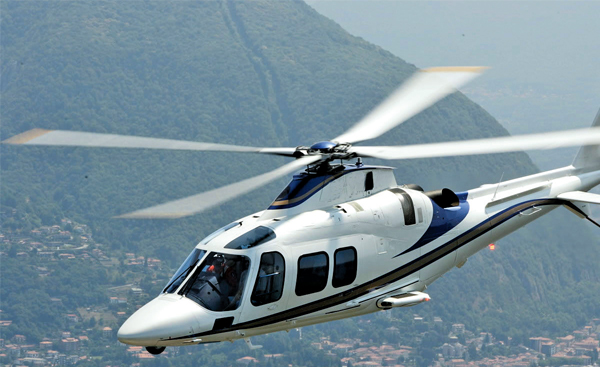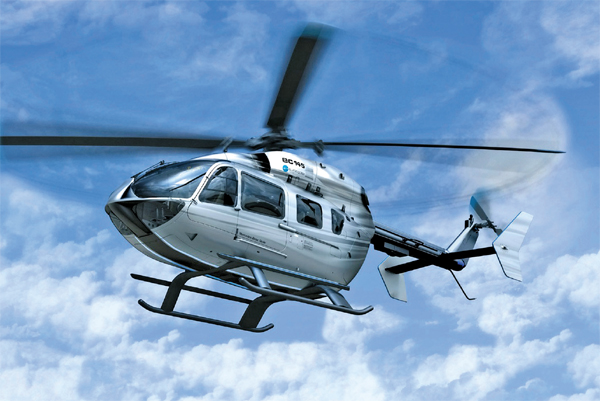|
Global five year demand is split almost 50-50
between the Americas and rest of the world involving
an increase of almost 5,000-5,500 machines. Latin
America and Asia will continue to have highest
fleet replacement and expansion expectations and
remain the world’s third largest regional market,
following North America and Europe. Drivers for
these expectations are aircraft age and condition,
contractual requirements, expiring warranties
and regulations requiring twin engines (off shore
operations). This is further supported by the
fact that the helicopter usage for corporate,
oil and gas, utility and training is increasing
manifold in these regions making the helicopter
a value add in the current business environment.
HELICOPTER MARKET - INDIA
India’s civil aviation market is today
among the fastest growing in the world, but helicopter
use remains very limited. From the time the first
civil helicopter was flown in India in November
1953 and up to 1986 the commercial use of helicopters
in India was limited to small aviation companies
involved in communication and crop spraying. The
growth of civil helicopter fleet in the early
years was very modest. The formation of the Helicopter
Corporation of India in 1986 (Later Pawan Hans
Helicopters Ltd), provided the first boost to
the civil helicopter industry in India, which
now holds and operates the largest fleet in the
country. While the numbers had reached 293 in
2012, the same has seen a decline in the beginning
of 2013 due to factors purely related to high
cost of operations and regulatory bottlenecks,
rather than the market prospects which continue
to be positive. Today, there are approximately
266 civil registered helicopters in the country,
with about 76 commercial operators. However, this
number is woefully inadequate when compared with
the world population of civil helicopters. As
per the available data, out of a total world civil
helicopter population of 34,000 plus, India accounts
for less than one per cent. Infact, India currently
has fewer civil helicopters than Switzerland.
In Brazil – a developing country like ours
– the city of Sao Paulo (similar to Bombay
and Delhi) itself has about 750 helicopters. However,
despite the above statistics, the market and industry
remains optimistic on the India helicopter story.
This is clearly demonstrated by the establishing
of joint ventures in India by helicopter majors
like AgustaWestland, Sikorsky and Eurocopter,
hoping that local production will give them an
edge as they compete to win orders.
COMMERCIAL PROSPECTS
As per world statistics, 40 per cent of all
civil helicopters are being used for corporate
business, 29 per cent for emergency medical services
and law enforcement, 16 per cent for offshore
operations and the balance for other operations
like heli-tourism, adventure sports, aerial surveys,
etc. This indicates that almost one-third of helicopters
worldwide are being used for law enforcement and
emergency medical services which is almost non-existent
in India. Presently, majority of the commercial
helicopters available are being used in the energy
sector – both onshore and offshore. The balance
helicopters are employed in communications, corporate
use, medical evacuation (air taxi/ambulance),
heli-tourism/pilgrimage, elections and other services
like survey and pipe line monitoring. Stakeholders
are today prepared to commit large investments
in offshore exploration and production particularly
in deep sea areas so far left untouched. Helicopters
form an important and integral part of such operations.
In India presently there are 50 plus helicopters
employed in the offshore sector on the western
and eastern coasts. These helicopters account
for over 75 per cent of the total civil helicopter
flying hours logged in the country As the exploration
moves further offshore, the requirement is for
modern helicopters with better range and advanced
safety features. Much of the above expected growth
will therefore be driven by the burgeoning offshore
oil and gas industry, as major obstacles remain
in the business aviation growth.
TYPES OF HELICOPTERS
The type of helicopters used in the civil market
is strongly influenced by the performance criteria
of the helicopter in terms of speed, range, safety
and reliability, hot/high capability, cabin size
and brand experience. Light single engine helicopters
continue to be the most popular product class
with Eurocopter’s EC 130/AS 350, Bell 407,
Robinson R-66 and AgustaWestland’s AW 109
the most sought after models. These models are
also flying in India. The next in line are the
Intermediate/Medium Twin-Engine helicopters. The
models most commonly seen in this segment are
the AW139, AW169, Bell 412, EC 145 and Sikorsky
S-76. These types of helicopters are more in demand
in the oil and gas arena and are certainly more
expensive to operate. The heavy twin/multi-engine
class of helicopters have a very small share in
civil market and are found mostly in the military
domain due to their specialised nature and heavy
operational costs - typical models are Eurocopter’s
EC 225, Russian MI 171 and Sikorsky’s S-92
(joint venture with Tata’s set up in Hyderabad).
In fact the MI 171 owned by Pawan Hans Limited
was involved in a fatal crash in Tawang in Arunachal
Pradesh killing the chief minister along with
18 others.

BOTTLENECKS TO GROWTH
With the world market surveys showing a positive
growth in India in the coming five years and tremendous
commercial prospects existing as seen above, why
are the numbers dwindling? The main hurdle is
the surfeit of fiscal and regulatory bottlenecks
thrust on the operators by the bureaucracy. These
are enumerated below.
High Cost of Operations: Turbine fuel, customs
duty for import of helicopters/spares and application
of fixed wing air traffic rules to helicopters
have stymied the growth of civil helicopter industry
to a large extent. Another major problem is lack
of infrastructure. While the scope of operations
and utilisation for commercial helicopters is
vast, the requisite infrastructure is almost non-existent
both in the metros and remote areas.
Availability of Pilots and Training Facilities:
With the expanding civil helicopter industry the
demand for pilots is ever increasing. Presently
80 per cent of pilots are being provided through
the armed forces (Retirees/Premature Retirees).
There is a need to boost up the training facilities
to get pilots from the civil street.
Regulatory Bottlenecks: The biggest bottleneck
is the applicability of fixed wing operation regulations
to helicopter operations. Fortunately, based on
the recommendations of the Parliamentary Committee
on Aviation the requirement for looking into helicopter
operations in a more holistic manner is being
pursued but the progress is lethargic to say the
least. There is a need for clearing regulatory
bottlenecks faced by the industry on a fast track
to enhance growth and smooth operations. While
some action for having separate corridors for
operation of helicopters in Delhi and Mumbai airspace
is in progress the pace is again very slow. This
is a major step that will help in increasing safety
as well as efficiency and capacity for helicopter
operations.

CONCLUSION
Despite these bottlenecks, India due to its terrain
and vastness is a helicopter country and offers
phenomenal potential for usage of civil helicopters
for public good. However, for this industry to
grow and become viable there is a need to address
these issues on priority by the main stake holders,
like the Ministry of Civil Aviation(MOCA), the
Director General Civil Aviation (DGCA) and the
Airports Authority of India (AAI), failing which
the prospects will remain gloomy, proving all
world market surveys wrong. The MOCA strategy
for the civil aviation sector in the next five
years includes providing impetus for growth of
helicopter industry and this must be implemented
seriously.
|